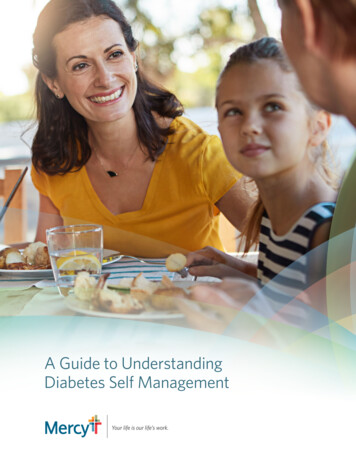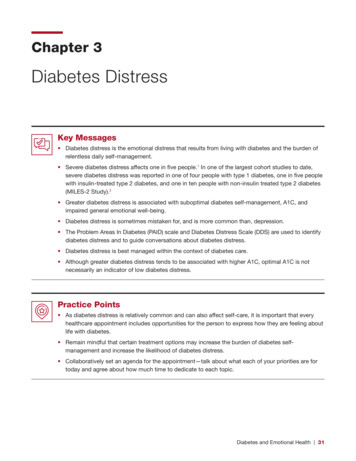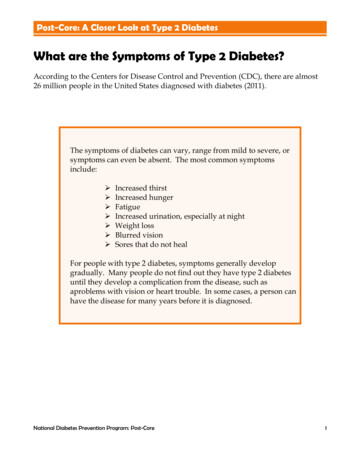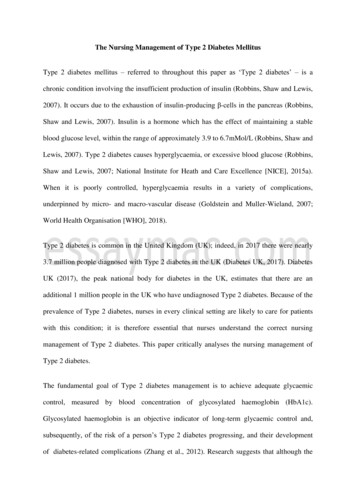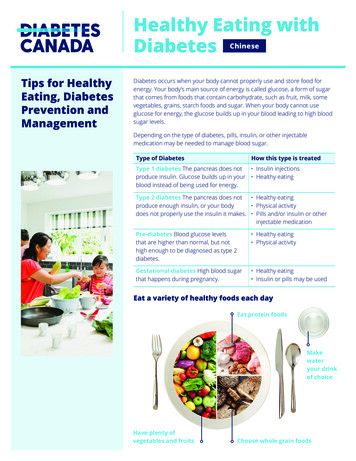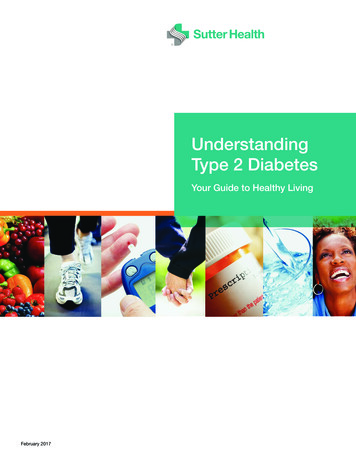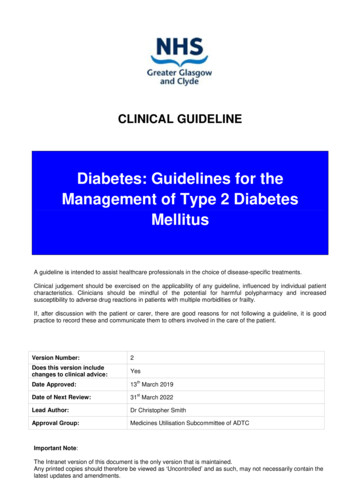
Transcription
Balanced information for better careManaging type 2 diabetesNew trials and guidelines are transforming medication use
Type 2 diabetes is common, but its riskcan be reduced with lifestyle changesPrediabetes (HbA1c 5.7-6.4%) affects more than 80 million people.1FIGURE 1. Diet and exercise can reduce or delay the progression from prediabetes todiabetes, especially in older adults.2Progression to diabetes inpatients with pre-diabetes(per 100 person years)12placebometformin10lifestyle8642025-44 years45-59 years60 yearsAgeDiabetes Prevention ProgramsDPP support lifestyle changes in patients with prediabetesthrough exercise and wellness programs certified by the CDC.To learn more about referring patients and to find programs inyour area, visit AlosaHealth.org/Prediabetes.Over 30 million Americans have diabetes (HbA1c 6.5%),1including more than 10% of adult Pennsylvanians.32Managing type 2 diabetes
Select HbA1c goal based on patientcharacteristicsFIGURE 2. For most adults, the HbA1c target is 7%. But the proper goal can change aspatients age, especially in older adults with comorbidities, cognitive decline, or frailty.4HbA1c goal 6.5% 7% 8% 8.5%Tighter targetTypicalRelaxed targetLooser targetNewly diagnosed,younger patientswithout cardiacdiseaseBest target formost patientsOlder patients withother comorbidities(or reducedfunctional status)Older patients withfrailty, end-stagedisease, or limitedlife expectancyBegin with lifestyle changes, adding metformin if needed.FIGURE 3. Diet and exercise are a central component of management; medications suchas metformin will be needed if greater HbA1c lowering is required.DIET Reduce calories toachieve weight loss. Favor whole grains,nuts, fruits, andvegetables overrefined andprocessed foods.EXERCISE Set a goal of 150minutes of physicalactivity per week. A combination ofaerobic and resistancetraining is best atlowering HbA1c.METFORMIN Safe side effect profile Low cost Start at a low doseto reduce GI sideeffects, then increasedose.Diabetes self-management programs can help patients make lifestyle changes. So can othermembers of the healthcare team, including diabetes educators, nurses, pharmacists, andnutritionists. Links to diabetes education resources are at AlosaHealth.org/Diabetes.Alosa Health Balanced information for better care3
In patients with cardiac disease, newerglucose lowering drugs prevent CV eventsAll these studies were conducted in patients already taking metformin.Sodium-glucose cotransporter-2 (SGLT-2) inhibitors or ‘flozins’FIGURE 4. The EMPA-REG trial showed that empagliflozin (Jardiance) reduced the risk% of patients with primaryoutcome*of cardiovascular events more than placebo.520placeboHazard ratio, 0.86 (95.02% CI, 0.74–0.99)p 0.04 for superiority1514% relative agliflozin (Invokana) also provided CV benefit over placebo. The effect of dapagliflozin(Farxiga) was mixed.6,7Glucagon-like peptide-1 receptor agonists (GLP-1) FIGURE 5. Liraglutide (Victoza) reduced the relative risk of CV outcomes 13% more% of patients with primaryoutcome*than placebo in the LEADER trial.820placeboHazard ratio, 0.87 (95% CI, 0.78–0.97)p 0.001 for noninferiorityp 0.01 for superiority1513% relative reduction10liraglutide500612182430Month36424854Not all GLP-1s have been shown to reduce CV outcomes. Semaglutide (Ozempic) reducedCV events more than placebo (relative reduction, 26%), but exenatide weekly (Bydureon)was no better than placebo in doing so.9,10Management of hypertension and cholesterol can also reduce CV risk.* Primary outcomes were CV death, non-fatal myocardial infarction, and non-fatal stroke.4Managing type 2 diabetes
Newer medications can also reduceheart failure and renal damageHospitalization for heart failureFIGURE 6. All SGLT-2 inhibitors (flozins) studied significantly reduced the risk of heartfailure hospitalization compared to 0-10Relative riskof heart failurehospitalization (%)-27%-33%-35%-20-30-40However, GLP-1s did not differ from placebo in preventing heart failure outcomes.Progression of nephropathyTABLE 1. GLP-1s and SGLT-2 inhibitors (flozins) significantly slowed decline in renalfunction compared to placebo.6-9,11ClassSGLT-2inhibitors% with worsening renal functionOn MedicationOn PlaceboRelative riskreductionempagliflozin (Jardiance)13%19%39%canagliflozin dapagliflozin (Farxiga)liraglutide (Victoza)GLP-1semaglutide (Ozempic)Decline in renal function was defined as a 40% reduction in eGFR, new renal replacement(e.g., dialysis), or death due to renal disease.The cardiovascular and renal benefits of these drugs are independent oftheir glucose lowering effects.Alosa Health Balanced information for better care5
Moving further toward the HbA1c goalWhat to do when lifestyle and metformin are not enoughFIGURE 7. Treatment paths for patients who are not at HbA1c goal. Use patient characteristics,preferences, and insurance coverage to select the best regimen.4Start metformin and lifestyle interventions.Reinforce diet and exercise; assess adherence and optimize dose at each step.Does the patient have atherosclerotic cardiovascular disease (ASCVD),chronic kidney disease (CKD), or heart failure (HF)?YNASCVDCKD or HFAdd a SGLT-2(empa, cana)or a GLP-1 (lira, sema)Add a SGLT-2(empa, cana, or dapa)Add a SGLT-2 or GLP-1or a DPP-4or pioglitazoneAdd a SGLT-2 or GLP-1(not used above)Add a GLP-1(lira or sema)Add an agent notused above*Alternate drugsAdd a DPP-4,*or pioglitazone,or sulfonylureaAlternate drugsAdd a DPP-4* (lina, sita)or a sulfonylureaAdd a sulfonylureaAdd a GLP-1, if notalready taking one*Initiate basal insulin*** Avoid prescribing a DPP-4 and GLP-1 together.** Basal insulin can be initiated if needed at any point.6Managing type 2 diabetesSECONDAGENTTHIRDAGENT
Select drug based on patient factorsTABLE 2. Medication effects and considerations for prescribingCV outcomeClass / medicationASCVDbiguanidemetformin (Glucophage)benefitHF*iageymannsg athehcnioi pcytlntuoghase rpoecor pheigW neWHyPr*lossnoGI intolerance(start with lowdose to minimize)noUTI,ketoacidosis,genital infections,hypotension,fractures (cana),amputation (cana)SGLT-2 inhibitors (flozins)canagliflozin (Invokana)empagliflozin (Jardiance)benefitdapagliflozin (Farxiga)neutralertagliflozin ossGLP-1 receptor agonistsliraglutide (Victoza)semaglutide† (Ozempic)exenatide† (Bydureon)lixisenatide (Adlyxin)dulaglutide† (Trulicity)exenatide (Byetta)neutralneutral****neutralneutral*lossnoGI side effectscommonpancreatitisDPP-4 inhibitors (gliptins)linagliptin (Tradjenta)sitagliptin (Januvia)alogliptin (Nesina)saxagliptin (Onglyza)*nojoint pain,pancreatitisbone fractures,bladder cancer*potentialrisk**Thiazolidinediones (TZD)pioglitazone buride (DiaBeta, Glynase)neutral**gainyesgainyesglipizide (Glucotrol)glimepiride (Amyarl)******insulinlispro, aspart, glulisine,regular, NPHglargine, degludec,detemirneutral***no data available; † given weeklyRenal dose adjustment is required for metformin, GLP-1s, and SGLT-2 inhibitors.Alosa Health Balanced information for better care7
The other ‘resistance’: starting insulinMany patients can successfully achieve their HbA1c target with basalinsulin (e.g., NPH, glargine) combined with other non-insulin agents.FIGURE 8. If insulin is required to reach the HbA1c goal, initiate basal insulin first,adding mealtime doses as needed to achieve goal.4Start basal insulin. Initial dose: 10 units or 0.1-0.2 mg/kg Titrate based on self-monitored fastingplasma glucose.If still above HbA1c goalAdd mealtimeinsulin at main mealof the day. Start with 4 units or 10% of basal dose. Titrate based on self-monitoredpost-prandial glucose.If still above HbA1c goalAdd mealtime insulinat other meals. If using pre-mixed insulin, dose upto twice daily.TABLE 3. The “Treat to Target” criteria provide an evidence-based approach to increaseinsulin doses in patients without frailty or cognitive impairment.12 Start with 10 units of basal insulin (either intermediate or long-acting insulin) at bedtime. Adjust insulin dose every week, based on the mean self-monitored fasting blood glucose(FBG) values from the previous 2 days.If mean FPG is:Increase insulin by:100-120 mg/dL2 units120-140 mg/dL4 units140-180 mg/dL6 units 180 mg/dL8 unitsA slower, more gradual titration may be required for older adults to avoid hypoglycemia.8Managing type 2 diabetes
Preventing hypoglycemia in frail older adultsReassessing insulin regimens can: avoid hypoglycemia, which can cause poorer outcomes in older adults. reduce treatment burden and the number of injections required each day.FIGURE 9. A small pragmatic implementation study in older people with diabetes usedan algorithm to simplify the insulin regimen.4,13Optimize basal insulinRemove mealtime insulinand add non-insulin drugsChange basal insulin.Change mealtime insulin. Convert all long-actinginsulins to glargine. Give glargine in the morning.Dose 10 unitsDiscontinue andadd non-insulinagent.* Titrate insulindown as non-insulinagent increases.Titrate based on weekly fastingglucose (goal 90-150 mg/dL).If 50% of readingsare above goal,increase by 2 units.If two readings 80 mg/dL,decrease by 2 units.Dose 10 units Decrease 50%and add non-insulinagent.** Select non-insulin agents using the algorithmon page 6, starting with metformin if toleratedand if renal function permits.Insulin simplification:133lowered time in hypoglycemia nearly 3-fold,3reduced insulin injections from almost 4 injections to 1 a day, and3did not change HbA1c control.Alosa Health Balanced information for better care9
CostsFIGURE 10. Price of agents used to treat diabetesCost for a 30-day supply of glucose lowering agentsmetformin 2000 mg 4metformin XR 2000 mg 4glipizide XL 10 mg 9glipizide 10 mg 4glimepiride 2 mg 4glyburide 5 mg 9pioglitazone 30 mg 9alogliptin (Nesina) 25 mg 174linagliptin (Tradjenta) 5 mg 490saxagliptin (Onglyza) 5 mg 488sitagliptin (Januvia) 100 mg 493canagliflozin (Invokana) 200 mg 1113dapagliflozin (Farxgia) 10 mg 544empagliflozin (Jardiance) 25 mg 569ertugliflozin (Steglatro) 10 mg 609dulaglutide (Trulicity) 1.5 mg weekly 821exenatide (Byetta) 0.01 mg 850exenatide XR (Bydureon) 2 mg weekly 821liraglutide (Victoza) 1.2 mg 707lixisenatide (Adlyxin) 0.02 mg 599semaglutide (Ozempic) 0.5 mg weekly 860Cost for 1,000 units of insulinregular (Humulin R vial) 100 units/mL 179regular (Humulin R KwikPen) 500 units/mL 246regular (Novolin R vial) 100 units/mL 143aspart (Novolog FlexPen) 100 units/mL 409aspart (Novolog vial) 100 units/mL 332aspart (Fiasp vial) 100 units/mL 295lispro (Humalog KwikPen) 100 units/mLNPH, Regular, and70/30 premix are availablefor 25 a vial at Wal-Mart. 418lispro (Humalog vial) 100 units/mL 319lispro (Admelog SoloStar) 100 units/mL 418lispro (Admelog vial) 100 units/mL 279NPH (Humulin N KwikPen) 100 units/mL 361NPH (Humulin N vial) 100 units/mL 176NPH (Novolin N vial) 100 units/mL 143detemir (Levemir FlexTouch) 100 units/mL 311detemir (Levemir vial) 100 units/mL 335glargine (Lantus SoloStar) 100 units/mL 295glargine (Lantus vial) 100 units/mL 299glargine (Basaglar KwikPen) 100 units/mL 259glargine (Toujeo SoloStar) 300 units/mL 310degludec (Tresiba FlexTouch) 100 units/mL 369NPH regular (Humulin KwikPen) 70 30 units/mL 201NPH regular (Humulin vial) 70 30 units/mL 172NPH lispro (Humalog KwikPen) 75 25 units/mL 225NPH lispro (Humalog vial) 75 25 units/mL 330glargine lixisenatide (Soliqua) 100 units 33 mcg/mL 506degludec liraglutide (Xultophy) 100 units 3.6 mg/mL 7800 100 200 300 400 500 600 700 800 900Prices from goodrx.com, January 2019. Listed doses are based on Defined Daily Doses by the World Health Organization and should not beused for dosing in all patients. All prices shown are for generics when available, unless otherwise noted. These prices are a guide; patientcosts will be subject to copays, rebates, and other incentives.10Managing type 2 diabetes
Key messages Diet and exercise can slow the progression of prediabetes to type 2 diabetes,and can improve glucose control in patients with established diabetes. Aim for a target HbA1c of 7% for most patients, but modify the goal (to 8.5%)for many frail older patients in whom overtreatment can pose its own risks. Use metformin as the initial treatment for the vast majority of patients whorequire drug treatment. Focus on adherence before increasing doses or adding a new drug. Intensify treatment with a second agent for patients who are not controlledon metformin.——Choose a second-line treatment based on patient characteristics.——Prescribe a GLP-1 or SGLT-2 inhibitor for patients with ASCVD, heart failure,or CKD, based on trial data. Add insulin promptly when other agents are not sufficient to achieveHbA1c goal. In all patients with diabetes, manage hypertension and hyperlipidemiaaggressively, and focus on smoking cessation when necessary. Continuously promote weight control, exercise, and adherence to medications.More information is available at AlosaHealth.org/Diabetes.References:(1) Centers for Disease Control and Prevention. National diabetes statistic report, 2017. Atlanta, GA: Centers for Disease Control andPrevention, U.S. Dept of Health and Human Services;2017. (2) Crandall J, Schade D, Ma Y, et al. The influence of age on the effects oflifestyle modification and metformin in prevention of diabetes. J Gerontol A Biol Sci Med Sci. 2006;61(10):1075-1081. (3) Diagnosed esAtlas.html. Accessed 26 Jan 2019. (4) American Diabetes Association. Standards of medicalcare in diabetes-2019. Diabetes Care. 2019;42(Suppl 1):S1-S193. (5) Zinman B, Wanner C, Lachin JM, et al. Empagliflozin, CardiovascularOutcomes, and Mortality in Type 2 Diabetes. N Engl J Med. 2015;373(22):2117-2128. (6) Neal B, Perkovic V, Mahaffey KW, et al. Canagliflozinand Cardiovascular and Renal Events in Type 2 Diabetes. N Engl J Med. 2017;377(7):644-657. (7) Wiviott SD, Raz I, Bonaca MP, et al.Dapagliflozin and Cardiovascular Outcomes in Type 2 Diabetes. N Engl J Med. 2019;380(4):347-357. (8) Marso SP, Daniels GH, BrownFrandsen K, et al. Liraglutide and Cardiovascular Outcomes in Type 2 Diabetes. N Engl J Med. 2016;375(4):311-322. (9) Marso SP, Bain SC,Consoli A, et al. Semaglutide and Cardiovascular Outcomes in Patients with Type 2 Diabetes. N Engl J Med. 2016;375(19):1834-1844.(10) Holman RR, Bethel MA, Mentz RJ, et al. Effects of Once-Weekly Exenatide on Cardiovascular Outcomes in Type 2 Diabetes. N Engl J Med.2017;377(13):1228-1239. (11) Wanner C, Inzucchi SE, Lachin JM, et al. Empagliflozin and Progression of Kidney Disease in Type 2 Diabetes.N Engl J Med. 2016;375(4):323-334. (12) Riddle MC, Rosenstock J, Gerich J. The treat-to-target trial: randomized addition of glargine or humanNPH insulin to oral therapy of type 2 diabetic patients. Diabetes Care. 2003;26(11):3080-3086. (13) Munshi MN, Slyne C, Segal AR, Saul N,Lyons C, Weinger K. Simplification of Insulin Regimen in Older Adults and Risk of Hypoglycemia. JAMA Intern Med. 2016;176(7):1023-1025.Alosa Health Balanced information for better care11
About this publicationThese are general recommendations only; specific clinical decisions should be made by thetreating physician based on an individual patient’s clinical condition. More detailed informationon this topic is provided in a longer evidence document at AlosaHealth.org.The Independent Drug Information Service (IDIS) is supported bythe PACE Program of the Department of Aging of the Commonwealthof Pennsylvania.This material is provided by Alosa Health, a nonprofit organizationwhich is not affiliated with any pharmaceutical company. IDIS is aprogram of Alosa Health.This material was produced by Marie McDonnell, M.D., endocrinologist and Director of the BrighamDiabetes Program at the Brigham and Women’s Hospital and Lecturer in Medicine at Harvard MedicalSchool; Michael A. Fischer, M.D., M.S., Associate Professor of Medicine (principal editor); Jerry Avorn,M.D., Professor of Medicine; Dae Kim, M.D., M.P.H., Sc.D., Assistant Professor of Medicine; Jing Luo,M.D., M.P.H., Instructor in Medicine, all at Harvard Medical School; and Ellen Dancel, PharmD, M.P.H.,Director of Clinical Materials Development, Alosa Health. Drs. Avorn, Fischer, Luo, and McDonnellare physicians at the Brigham and Women’s Hospital, and Dr. Kim practices at the Beth Israel DeaconessMedical Center and Hebrew Senior Life, both in Boston. None of the authors accepts any personalcompensation from any drug company.Medical writer: Stephen Braun.Copyright 2019 by Alosa Health. All rights reserved.
2 anaging type 2 diabetes Type 2 diabetes is common, but its risk can be reduced with lifestyle changes Over 30 million Americans have diabetes (HbA1c 6.5%),1 including more than 10% of adult Pennsylvanians.3 FIGURE 1. Diet and exercise can reduce or delay the progression from prediabetes to diabetes, especially in older adults.2 placebo .
